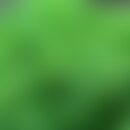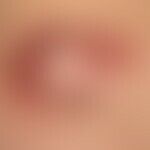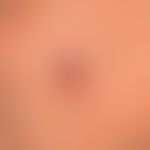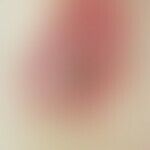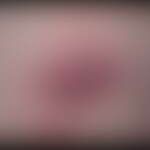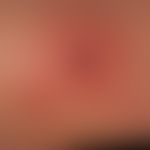Synonym(s)
DefinitionThis section has been translated automatically.
Bacterially induced, corium and subcutaneous (deep folliculitis), painful, staphylococcal, abscessed inflammation of a hair follicle with retracted scar healing. Furunculus maligna is the name given to the (in Central Europe very rare) anthrax carbuncle with extensive central necrosis.
Occurrence/EpidemiologyThis section has been translated automatically.
Exact data are missing. A prevalence of 0.2-1.2/100 persons/year is given for the age group 30-50 years.
You might also be interested in
EtiopathogenesisThis section has been translated automatically.
Mostly infection with Staphylococcus aureus, especially in patients with a weakened immune system. Development from folliculitis. Several boils can conflate to form a carbuncle.
LocalizationThis section has been translated automatically.
Preferably neck, buttocks, inner thigh, outer auditory canal, upper lip (see lip furuncle).
ClinicThis section has been translated automatically.
Differential diagnosisThis section has been translated automatically.
- Folliculitis simplex: only superficial infection of the follicle (ostiofolliculitis) Pustular formation around a hair shaft.
- Infected epidermoid cyst: painful, inflammatory lumps, usually appearing suddenly after an attempt to squeeze out
- Lymphomatoid papulosis: slowly growing painless lump. No abscess formation. Diagnosis: biopsy.
- Trichophytia profunda: furuncoloid nodule, mostly in children, low painfulness. Diagnosis: biopsy.
- Furuncoloid myiasis: typical traveler's dermatosis. Slowly growing. No significant painfulness.
- Leishmaniasis: typical traveler's dermatosis (where the olive tree grows). Slowly growing inflammatory granuloma, not fluctuating, central ulceration
- Boils in groins/axillae:
- Hidradenitis suppurativa: rarely acute. Mostly occurring as a recurrent process over many years.
- Boils in the eyelid area:
- Hordeolum (barleycorn): bacterial infection of the eyelashes. Typical localisation and anamnesis
Complication(s)(associated diseasesThis section has been translated automatically.
- Regional lymphangitis, lymphadenitis
- in nasal and upper lip furuncles: infectious thrombosis of the cavernous sinus and thrombophlebitic sepsis possible (very rare complication)
- Recurrent furuncle formation (see below furunculosis) in immunologically disturbed patients
- Fiasciitis necroticans: Rare, life-threatening, fulminant, deep, phlegmonous infection of the skin, subcutis and fasciae occurring in diabetics after trivial injuries.
- Facial furuncle (esp. furuncle/carbuncle of the centrofacial region)
- Due to the topographical proximity to the eye and brain region, there is an increased risk of complications, which is why i.v. antibiotic therapy is always required!
- Complications: Orbital phlegmon, meningitis, sinus cavernosus thrombosis
General therapyThis section has been translated automatically.
Immobilize the affected part of the body, elevate as much as possible. No manipulation: no pressing on the boil! In case of facial furuncle: bed rest, no talking, as well as change to soft, passed fare.
External therapyThis section has been translated automatically.
- So-called "pull ointments" and the application of moist heat are traditionally used. 10, 20 or 50% ichthyol ointments are called "pull-alves". On the neck, face and genitals, however, these shale oil sulfonates should only be used up to 20%.
- Damp warm compresses at the beginning with antimicrobial additives such as polihexanide (Serasept, Prontoderm), diluted potassium permanganate solution(light pink), quinolinol (e.g. Chinosol 1:1000) or R042, polyvidone-iodine solution(e.g. Betaisodona solution). In addition, 0.5% Clioquinol in Lotio alba R050 or Clioquinol ointment (Linola-Sept), also treat the surrounding area.
- Incision and drainage of the abscess cavity is necessary in case of significant fluctuation of the abscess. Irrigation with polihexanide solution or polyvidon iodine solution(e.g. Betaisodona solution) insertion of a gauze strip soaked with polyvidon iodine ointment.
Radiation therapyThis section has been translated automatically.
Internal therapyThis section has been translated automatically.
- Intravenous antibiotic therapy: In the case of facial furuncles, intravenous antibiotics, e.g. with oxacillin (e.g. InfectoStaph), should be preferred: Adults 2-4 g/day i.v. in 4-6 ED, children 1-6 years 1-2 g/day i.v. in 4 doses, infants over 3 months 4 times/day 20 mg/kg bw, infants up to 3 months 3 times/day 20 mg/kg bw, in newborns and premature infants the indicated dose should only be administered twice/day.
- Peroral antibiotic therapy: adults, adolescents, children from 6 years InfectoStaph Kps. 2-3 g/day in 4-6 doses. Children 1-6 years 2 g/day in 4 sessions. In case of severe infections, doubling of the dose is possible.
- In case of suspected penicillin allergy to erythromycin (e.g. Monomycin Kps.): Adults, children over 8 years: 4 times/day 250 mg or 2 times/day 500 mg p.o. Infants, toddlers: Monomycin juice/infant juice 30-50 mg/kg bw/day in 3-4 single doses at meals.
- Alternatively, the more stomach-tolerant Roxithromycin (Rulid Filmtbl.): Adults, adolescents (over 40 kg) 2 times/day 150 mg p.o. or 1 time / day 300 mg p.o. In advanced liver disease dose halve. Children, infants receive Rulid junior Btl. 30-50 mg/kg bw/day in 3-4 doses before meals.
- In case of resistance to the above antibiotics, use vancomycin: adults 4 times/day 0.5 g i.v. or twice/day 1.0 g i.v., children > 1 year 40 mg/kg bw in 2-4 doses, infants < 1 week 20 mg/kg bw in 2 doses, infants > 1 week 30 mg/kg bw in 3 doses.
NaturopathyThis section has been translated automatically.
Alternative: Immobilization, warm and moist compresses, after opening the furuncle drainage with marigold mother tincture diluted in Ringer's solution (1:20).
Phytotherapy externalThis section has been translated automatically.
Althaeae folium, Althaeae radix, Foenugraeci Semen, Meliloti herba, Melaleuca alternifolia, Myrrh, see also under Arctii radix
LiteratureThis section has been translated automatically.
Schöfer H et al (2011) S2k + IDA Guideline: Diagnosis and therapy of Staphylococcus aureus infections of the skin and mucous membranes. AWMF Guideline
- van Bijnen EM et al(014) Evidence-based primary care treatment guidelines for skin infections in Europe: a comparative analysis.Eur J Gen Pract 20: 294-300.
Incoming links (41)
Acne keloidalis nuchae; Althaeae folium; Althaeae radix; Ammonium bituminosulfonate dark; Ammonium bituminosulfonate dark; Ammonium bituminosulfonate dark; Arctii radix; Auditory canal furuncle; Carbuncle; Ecthyma gangraenosum; ... Show allOutgoing links (32)
Althaeae folium; Althaeae radix; Ammonium bituminosulfonate dark; Anthrax of the skin; Antibiotics; Arctii radix; Clioquinol; Clioquinol lotio 0.5-5%; Epidermal cyst; Erythromycin; ... Show allDisclaimer
Please ask your physician for a reliable diagnosis. This website is only meant as a reference.
